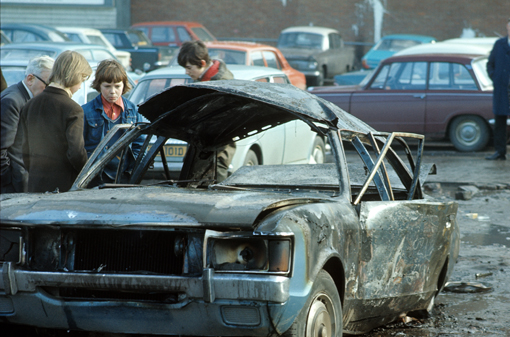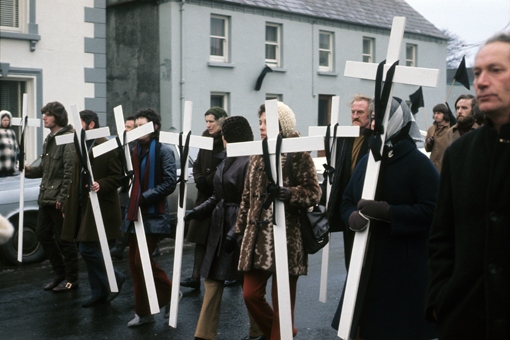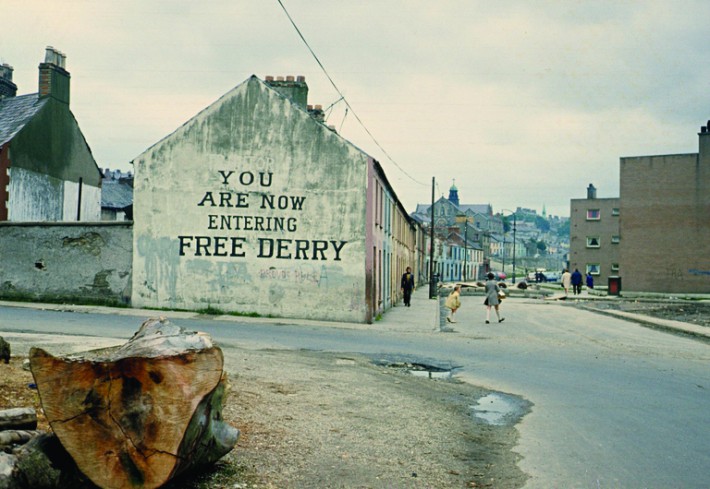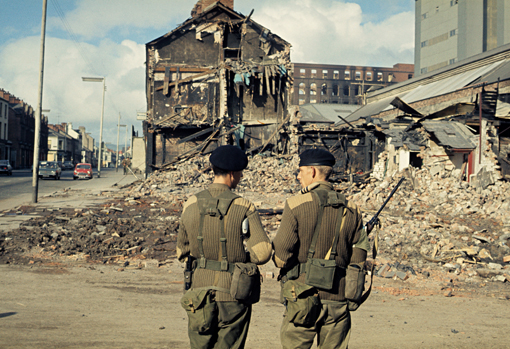Launched in March 2012, Chronicle: BBC Northern Ireland’s television news from the 60s and 70s is a new academic resource that brings together thousands of titles for the first time. Dr Martin Doherty, University of Westminster, provides a look at how the project was put together and considers its potential value as a historical resource. It can be accessed at: http://chronicle.bufvc.ac.uk/
 About the Author: Dr Martin Doherty, Head of the Department of Social and Historical Studies at the University of Westminster. Selected recent publications include: 'Evangelicalism on the Streets: Religion, community relations and constructive unionism. The Arklow Street Preaching Disturbances 1890-1892' in James H. Murphy (ed.) in Evangelicals and Catholics in Nineteenth-Century Ireland (Four Courts Press, Dublin 2005); Nazi Wireless Propaganda (Edinburgh University Press 2000).
About the Author: Dr Martin Doherty, Head of the Department of Social and Historical Studies at the University of Westminster. Selected recent publications include: 'Evangelicalism on the Streets: Religion, community relations and constructive unionism. The Arklow Street Preaching Disturbances 1890-1892' in James H. Murphy (ed.) in Evangelicals and Catholics in Nineteenth-Century Ireland (Four Courts Press, Dublin 2005); Nazi Wireless Propaganda (Edinburgh University Press 2000).
E-mail: M.A.Doherty@westminster.ac.uk
Ask anyone from Northern Ireland when ‘the Troubles’ began, and as like as not they will reply ‘5th October 1968’. On that day, participants in a banned civil rights march in Londonderry were set upon by a large force of baton-wielding members of the Royal Ulster Constabulary, after a bad-tempered confrontation in the city’s Duke Street. What made this episode stand out from so many others was the presence at the march of three television crews, one each from the state broadcaster of the Irish Republic, RTE, from the local ITV station, Ulster Television and one from BBC Northern Ireland. The pictures of policeman battering defenceless protesters caused outrage in nationalist Ireland and intense disquiet in Great Britain, finally obliging the government to take an interest in the benighted province it had ignored for nearly fifty years. The fallout from 5th October is a stark reminder of the power of the moving image to rouse audiences and embarrass governments, in ways which other media sometimes fail to do. And it is a reminder also of the fact that so much of our understanding of the modern world is shaped by television. Northern Ireland’s image for most of us for forty years has been one of bombs and bullets, murder and mayhem, because ‘we’ve seen it on the telly’.
historians will be tremendously excited by the launch of the Chronicle project
And it is for these and for many other reasons that historians will be tremendously excited by the launch of the Chronicle project, and enormously grateful to BBC Northern Ireland, JISC and the British Universities Film & Video Council for making it possible. The University of Westminster was one of five academic institutions involved in the project since its inception, which in itself was an excellent example of engagement between academia and the wider community. The development of the project was fascinating throughout and raised so many intriguing questions about presenting ‘raw’ audiovisual material of this kind: how should we select it? Given the potential sensitivity of much of the material, should we hold anything back? Should we impose a thematic structure on it? Did we need to provide contextualising material to help users ‘make sense of it’? In the end, we went for the simplest and, in retrospect, the best approach. There was no selection, no ‘screening’, no attempt to impose a structure on it, or give meaning to it. The entire BBC Northern Ireland news archive from 1963 to 1976 will be made available to students, teachers and researchers in completely unmediated form. What an excellent resource!
And it is the fact that it is ‘raw’ and unmediated which makes it so wonderful and so challenging. At Westminster, we offer a third-year undergraduate module called ‘The Troubles: Britain and Northern Ireland, 1968-1998’. The average student is aged about twenty-one, so that events from the early period of the Troubles are as remote to them as the Blitz is to people of my generation. What they think they know about the Troubles comes from what they have seen on television. It soon becomes clear to them however, that the Northern Ireland situation is about much more than backward sectarianism, and Chronicle is already being used to help students appreciated its complexity. There are libraries full of scholarly material attempting to make sense of the Troubles, but our emphasis is on working with primary source material in unmediated form, that is, without anyone else to ‘tell me what it means’. Those of us based in London are lucky to have ready access to the National Archives at Kew, and the wonderful CAIN site at the University of Ulster allows us online access to primary sources from the Public Records Office of Northern Ireland. Now Chronicle gives us the same type of access to primary audio-visual material on the unfolding, sometimes horrifying story of the Troubles, as they happened.
The richness of the material is stunning and only half of it has been uploaded yet. A search for ‘Londonderry’ produces 133 hits, and it’s endlessly fascinating to study pictures from a pre-Troubles Derry, as fresh-faced Eamonn McCann and Dermie McClenaghan support Janet Wilcock’s election campaign in May 1968. Gay O’Brien’s famous RTE pictures of the police attack on the October 5th marchers, have become painfully familiar thanks to endless repetition in television documentaries. How fascinating then to have unmediated access to Dick Macmillan’s BBC shots of the same events, filmed from an upstairs window in Duke Street, as an RUC water-cannon hoses Saturday shoppers, including one elderly lady grasping a bunch of flowers. How sad and poignant to hear the voices of the former residents of Belfast’s Bombay Street, burned out in August 1969, some terrified, some defiant, some optimistic, some unforgiving. And how shocking to see the deserted streets of the Falls Road, filmed from a moving vehicle during the Army-imposed curfew of July 1970. A search for ‘bomb’ produces 309 hits, the first as early as January 1968, but then becoming depressingly more frequent as the IRA campaign accelerated from 1971. How ghastly to see again those awful scenes from Bloody Friday, Belfast 1972, and how terrible to be reminded of the realities of life in Belfast in February 1976, by a story of the terrible death of an electricity inspector, killed by a booby-trap bomb in an empty house.
But Northern Ireland wasn’t all about murder and mayhem, and the great variety of sports, entertainment, economic, housing, health, welfare and education stories available in Chronicle, reminds us that in spite of everything, most people did their best to get on with life as normally as they could. And what a treat for those of us brought up with Scene Around Six in the 1970s to see again such old familiar faces as Barry Cowan, Larry McCoubrey, Diane Harron, David Capper, W.D. Flackes, Norman Stockton, Eric Waugh and of course, Gloria Hunniford.
The potential of this material in teaching and learning is immense. We have already been using it as supporting material in lectures, but its value as a resource comes out best in seminar work, when students are required to search and interrogate the material; to ask questions about its provenance and about how and why it was created; about its meaning, its likely perception by contemporary audiences and about its value as a source for historians some forty year after the event. For researchers, Chronicle is an enormous asset, for those studying the Troubles, but also for those studying ‘the story’ of the Troubles, as told by television. But users of the system do not have to be passive consumers only, and can make their own contribution to improving the value of the resource by contributing to the development of the meta-data through online posts, identifying individuals and locations, correcting errors, providing commentary and so on.
And of course, it is challenging. Much of it is mute, there are no scripts, the meta-data is often sparse, there are no recordings of actual news transmissions in broadcast form, so that sometimes one is left thinking, ‘what on earth is this about?’ But isn’t that what makes the study of the past so fascinating? Chronicle gives scholars unparalleled access to a key resource in the story of the Troubles and is an excellent addition to our growing store of outstanding online provision.
Dr Martin Doherty
BUFVC note:
The live service is available on http://chronicle.bufvc.ac.uk
To enable your institution to access this material immediately, please download and sign the sub-licence. Completed sub-licences should be emailed or returned by post to the BUFVC, 77 Wells Street, London W1T 3QJ (mark the envelope ‘Licensing’). Please remember to include all the contact details and information in the final sheet of the sub-licence.



